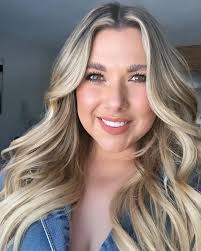Daily Extension Care That Actually Fits Your Life
You just got extensions and they look incredible. Then you get home and start overthinking everything. Can I brush them? How often should I wash them? What if I sleep wrong and ruin them overnight?
I talk clients through these questions constantly. Everyone's worried they're going to accidentally destroy their new hair. The truth is, taking care of extensions isn't nearly as complicated as people think. You don't need a whole new routine. You just need to adjust a few things you're already doing.
Let me break down what actually matters, without all the overthinking.
The Stuff You Need to Do Every Day
There are really only four things that matter for keeping extensions in good shape, and they work for every type of extension.
Brush Correctly
This is the biggest one. How you brush determines whether your extensions stay smooth or turn into a tangled mess.
Use a soft brush or one of those loop brushes made for extensions. Start at the very ends and work out any tangles there. Then move up a few inches and brush that section. Keep working your way up until you get to the roots.
Here's the part most people miss: hold the base of your extensions with one hand while you brush with the other. You're basically supporting the attachment point so you're not pulling on it. If you skip this step and just brush from top to bottom, you're yanking on those bonds or wefts, which loosens them over time.
Do this morning and night, minimum. Takes maybe two minutes once you get used to it.
Keep Them Moisturized
Your natural hair gets oils from your scalp. Extensions don't. They're just sitting there drying out unless you do something about it.
I tell clients to use a lightweight hair oil or serum every day on the middle and ends of their hair. Not the roots, not the attachment points. Just the actual extension hair. A couple drops is enough. This keeps everything soft and prevents that dry, brittle feeling.
Protect Them at Night
Before you go to sleep, put your hair in a loose braid or low ponytail. Something to keep it contained so it's not rubbing all over your pillow and creating friction.
And seriously, get a silk or satin pillowcase. I know everyone says this, but there's a reason. Cotton grabs hair and creates tangles. Silk lets it slide. The difference is noticeable.
I had a client who refused to do this at first because she thought it was unnecessary. After a month of dealing with constant tangles, she finally bought a silk pillowcase. Texted me a week later saying she wished she'd listened from the start.
Use the Right Products
Sulfate-free shampoo and conditioner. That's the rule. Sulfates are harsh and they'll dry out your extensions and break down the adhesive in your bonds or tapes.
Also, never put conditioner on your roots or attachment points. Only from mid-length down to the ends. Conditioner has oils and silicones that make things slip, and you don't want your extensions slipping.
What Changes Based on Your Type
Most of the care routine is the same for everyone, but there are a few specific things depending on what method you have.
If You Have Hand-Tied Wefts
When you wash, work the shampoo gently between the rows. Don't scrub the actual weft itself, that can damage it. Just clean your scalp and let the shampoo rinse through.
When brushing, be careful not to catch the bristles in the thread that's holding the weft. Support the weft with your hand and brush below it.
If You Have Tape-Ins
Keep all oils and alcohol away from the tapes. That stuff breaks down adhesive. When you wash, don't do circular scrubbing motions near the tapes. I tell clients to use a gentle back-and-forth motion instead.
Hold the tape panels firmly when you brush so you're not pulling on them.
If You Have K-Tips or Fusion Bonds
These can tangle at the root if you're not careful. When washing, be gentle at the scalp. Don't scrub aggressively.
Every day, run your fingers through near the bonds and gently separate any that are trying to stick together. It takes like thirty seconds and prevents bigger problems.
And never put conditioner or oil directly on the keratin bonds. It weakens them.
Your Morning Routine Doesn't Need to Be Complicated
Most mornings, you're not starting from scratch. You're just refreshing what's already there.
Take your hair out of the braid. Brush through it starting from the ends like I mentioned before.
Put a tiny bit of leave-in conditioner or serum through the middle and ends to smooth down any frizz.
If you're using heat tools, use a heat protectant first. Keep the temperature under 360 degrees. Higher than that and you're risking damage for no real benefit.
If you want to extend the time between washes, use dry shampoo on your roots. Not on the extensions themselves, just your actual scalp. It absorbs oil and gives you an extra day or two.
That's it. Five minutes and you're out the door.
When Things Go Wrong (And How to Fix Them)
Even when you're doing everything right, occasionally something goes sideways. Here's how to handle the most common problems.
Tangles at the back of your neck: This happens to everyone at some point. The nape of your neck rubs against collars and scarves all day.
When you find a tangle, don't panic and start ripping at it. Spray some detangling spray or leave-in conditioner on it. Use your fingers first to gently work it apart. If that doesn't work, use the tail end of a comb and work through it slowly from the bottom up.
I've had clients come in with mats because they ignored a small tangle for a week. Don't let it get to that point. Deal with it the day you notice it.
You put conditioner on your roots by accident: It happens. At your next wash, shampoo that area really well. You might need to shampoo twice to get all the residue out.
If you have tape-ins and you notice them feeling loose after this, call your stylist. Don't wait until they're falling out.
Your blonde extensions turned weird colors: Usually pink or orange-ish. This is almost always from sunscreen. Some ingredients in sunscreen react with hair and water and cause discoloration.
Keep sunscreen spray away from your hair. If it's already happened, your stylist can usually fix it with a clarifying treatment.
Everything feels dry and crunchy: You're not using enough oil or you're using too much heat without protection.
Up your daily oil application. Use a deep conditioning treatment once a week on the mid-lengths and ends. And check that you're actually using heat protectant before styling.
Adjusting for Your Actual Life
Not everyone's lifestyle is the same, so the routine needs to flex a little.
If your scalp gets really oily: You might need to wash more often, but focus on cleaning your scalp specifically. The extensions themselves don't need to be washed as much. Use dry shampoo between washes to manage the oil.
If you work out a lot: Put your hair in a tight braid or bun before working out to keep sweat from soaking into the bonds. After, you can rinse your scalp lightly or use dry shampoo. You don't need a full wash every time you exercise.
If you're always rushing: A good nighttime routine saves you so much time in the morning. Spending two minutes braiding your hair before bed means you wake up with smooth, manageable hair instead of a tangled mess that takes twenty minutes to fix.
The Stuff People Always Ask Me
"Is this going to take forever every day?"
No. Once it becomes habit, you're looking at maybe five minutes total. Two minutes to brush properly, thirty seconds for oil or serum, another minute or two for any styling. The nighttime braid takes less than a minute. It's really not bad.
"What if I forget to brush one day?"
One day isn't going to ruin everything. But don't make it a regular thing. The whole point of brushing daily is to prevent small tangles from becoming big ones. Consistency is what keeps things manageable.
"Can I just use my regular shampoo?"
Please don't. Most drugstore shampoos have sulfates that will strip your extensions and break down the bonds. They also often have heavy silicones that cause buildup or make tapes slip.
Extension-safe products aren't that expensive compared to what you paid for the extensions themselves. It's worth it.
"I have really fine natural hair. Is all this brushing going to damage it?"
This routine actually protects your natural hair. When you hold the base while brushing, you're taking all the tension off your roots. And keeping everything smooth and tangle-free means less breakage overall.
"What's the worst mistake people make?"
Going to bed with wet or damp extensions. Hands down. This is how you get severe matting at the roots that sometimes can't even be saved. Always make sure your hair, especially near the bonds or wefts, is completely dry before you lie down.
I've seen this ruin extensions that were only two weeks old. It's completely avoidable.
Here's the Bottom Line
Taking care of extensions is mostly about being consistent with simple stuff. Brush the right way twice a day. Use good products. Protect your hair at night. Keep extension hair moisturized. Handle tangles immediately.
None of it is difficult. It just requires actually doing it instead of skipping steps when you're tired or in a hurry.
The clients whose extensions always look great and last the full term aren't doing anything special. They're just following the basics without cutting corners. That's literally the only difference.
You spent good money on beautiful hair. Now spend five minutes a day keeping it that way. That's the deal.

Tiffany Loe
Owner & Master Stylist
Hair extension expert and salon owner with a passion for helping stylists succeed. Tiffany has been transforming hair and building confidence for over 15 years.




